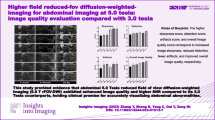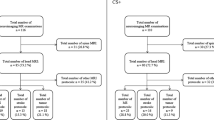Abstract
Purpose
A 3D fat-navigator (3D FatNavs)-based retrospective motion correction is an elegant approach to correct for motion as it requires no additional hardware and can be acquired during existing ‘dead-time’ within common 3D protocols. The purpose of this study was to clinically evaluate 3D FatNavs in the work-up of brain tumors.
Methods
An MRI-based fat-excitation motion navigator incorporated into a standard MPRAGE sequence was acquired in 40 consecutive patients with (or with suspected) brain tumors, pre and post-Gadolinium injection. Each case was categorized into key anatomical landmarks, the temporal lobes, the infra-tentorial region, the basal ganglia, the bifurcations of the middle cerebral artery, and the A2 segment of the anterior cerebral artery. First, the severity of motion in the non-corrected MPRAGE was assessed for each landmark, using a 5-point score from 0 (no artifacts) to 4 (non-diagnostic). Second, the improvement in image quality in each pair and for each landmark was assessed blindly using a 4-point score from 0 (identical) to 3 (strong correction).
Results
The mean image improvement score throughout the datasets was 0.54. Uncorrected cases with light and no artifacts displayed scores of 0.50 and 0.13, respectively, while cases with moderate artifacts, severe artifacts, and non-diagnostic image quality revealed a mean score of 1.17, 2.25, and 1.38, respectively.
Conclusion
Fat-navigator-based retrospective motion correction significantly improved MPRAGE image quality in restless patients during MRI acquisition. There was no loss of image quality in patients with little or no motion, and improvements were consistent in patients who moved more.




Similar content being viewed by others
References
Andre JB, Bresnahan BW, Mossa-Basha M, Hoff MN, Smith CP, Anzai Y, Cohen WA (2015) Toward quantifying the prevalence, severity, and cost associated with patient motion during clinical MR examinations. J Am Coll Radiol 12:689–695
Haacke EM, Patrick JL (1986) Reducing motion artifacts in two-dimensional Fourier transform imaging. Magn Reson Imaging 4:359–376
Ackerman J (1986) Rapid 3D tracking of small RF coils. In: Proc 5th annual meeting of ISMRM. Montréal, pp 1131–2
Zaitsev M, Dold C, Sakas G, Hennig J, Speck O (2006) Magnetic resonance imaging of freely moving objects: prospective real-time motion correction using an external optical motion tracking system. Neuroimage 31:1038–1050
Qin L, van Gelderen P, Derbyshire JA, Jin F, Lee J, de Zwart JA, Tao Y, Duyn JH (2009) Prospective head-movement correction for high-resolution MRI using an in-bore optical tracking system. Magn Reson Med 62:924–934
Schulz J, Siegert T, Reimer E, Labadie C, Maclaren J, Herbst M, Zaitsev M, Turner R (2012) An embedded optical tracking system for motion-corrected magnetic resonance imaging at 7T. Magn Reson Mater Physics Biol Med 25:443–453
Maclaren J, Armstrong BSR, Barrows RT, Danishad KA, Ernst T, Foster CL, Gumus K, Herbst M, Kadashevich IY, Kusik TP, Li Q, Lovell-Smith C, Prieto T, Schulze P, Speck O, Stucht D, Zaitsev M (2012) Measurement and correction of microscopic head motion during magnetic resonance imaging of the brain. PLoS One 7:e48088
Pipe JG (1999) Motion correction with PROPELLER MRI: application to head motion and free-breathing cardiac imaging. Magn Reson Med 42:963–969
Lin W, Huang F, Börnert P, Li Y, Reykowski A (2010) Motion correction using an enhanced floating navigator and GRAPPA operations. Magn Reson Med 63:339–348
Thesen S, Heid O, Mueller E, Schad LR (2000) Prospective acquisition correction for head motion with image-based tracking for real-time fMRI. Magn Reson Med 44:457–465
Tisdall MD, Hess AT, Reuter M, Meintjes EM, Fischl B, van der Kouwe AJW (2012) Volumetric navigators for prospective motion correction and selective reacquisition in neuroanatomical MRI. Magn Reson Med 68:389–399
White N, Roddey C, Shankaranarayanan A, Han E, Rettmann D, Santos J, Kuperman J, Dale A (2010) PROMO: real-time prospective motion correction in MRI using image-based tracking. Magn Reson Med 63:91–105
Skare S, Hartwig A, Mårtensson M, Avventi E, Engström M (2015) Properties of a 2D fat navigator for prospective image domain correction of nodding motion in brain MRI. Magn Reson Med 73:1110–1119
Engström M, Mårtensson M, Avventi E, Norbeck O, Skare S (2015) Collapsed fat navigators for brain 3D rigid body motion. Magn Reson Imaging 33:984–991
Kochunov P, Lancaster JL, Glahn DC, Purdy D, Laird AR, Gao F, Fox P (2006) Retrospective motion correction protocol for high-resolution anatomical MRI. Hum Brain Mapp 27:957–962
Brown TT, Kuperman JM, Erhart M, White NS, Roddey JC, Shankaranarayanan A, Han ET, Rettmann D, Dale AM (2010) Prospective motion correction of high-resolution magnetic resonance imaging data in children. Neuroimage 53:139–145
Vos SB, Micallef C, Barkhof F, Hill A, Winston GP, Ourselin S, Duncan JS (2018) Evaluation of prospective motion correction of high-resolution 3D-T2-FLAIR acquisitions in epilepsy patients. J Neuroradiol 45:368–373
Gallichan D, Marques JP, Gruetter R (2016) Retrospective correction of involuntary microscopic head movement using highly accelerated fat image navigators (3D FatNavs) at 7T. Magn Reson Med 75:1030–1039
Federau C, Gallichan D (2016) Motion-correction enabled ultra-high resolution in-vivo 7T-MRI of the brain. PLoS One 11:e0154974
Lüsebrink F, Sciarra A, Mattern H, Yakupov R, Speck O (2017) T1-weighted in vivo human whole brain MRI dataset with an ultrahigh isotropic resolution of 250 μm. Sci Data 4:170032
Brant-Zawadzki M, Gillan GD, Nitz WR (1992) MP RAGE: a three-dimensional, T1-weighted, gradient-echo sequence--initial experience in the brain. Radiology 182:769–775
Fessler JA Michigan Image Reconstruction Toolbox. http://web.eecs.umich.edu/~fessler/code/. Accessed 1 Aug 2018
SlicerCommunity 3DSlicer. https://www.slicer.org. Accessed 5 Jul 2018
Bland JM, Altman DG (1986) Statistical methods for assessing agreement between two methods of clinical measurement. Lancet (London, England) 1:307–310
McHugh ML (2012) Interrater reliability: the kappa statistic. Biochem Medica 22:276–282
van Minde D, Klaming L, Weda H (2013) Pinpointing moments of high anxiety during an MRI examination. Int J Behav Med 21:487–495
Acknowledgments
CF is supported by the Swiss National Science Foundation.
Author information
Authors and Affiliations
Corresponding author
Ethics declarations
Funding
No funding was received for this study.
Conflict of interest
The authors declare that they have no conflict of interest.
Ethical approval
All procedures performed in the studies involving human participants were in accordance with the ethical standards of the institutional and/or national research committee and with the 1964 Helsinki Declaration and its later amendments or comparable ethical standards.
Informed consent
Informed consent was obtained from all individual participants included in the study.
Additional information
Publisher’s note
Springer Nature remains neutral with regard to jurisdictional claims in published maps and institutional affiliations.
Rights and permissions
About this article
Cite this article
Glessgen, C., Gallichan, D., Moor, M. et al. Evaluation of 3D fat-navigator based retrospective motion correction in the clinical setting of patients with brain tumors. Neuroradiology 61, 557–563 (2019). https://doi.org/10.1007/s00234-019-02160-w
Received:
Accepted:
Published:
Issue Date:
DOI: https://doi.org/10.1007/s00234-019-02160-w




